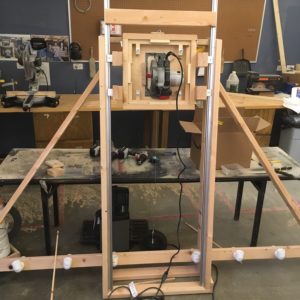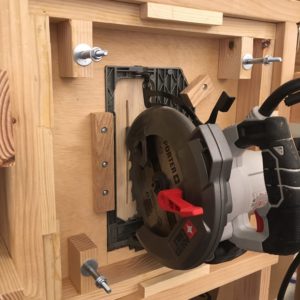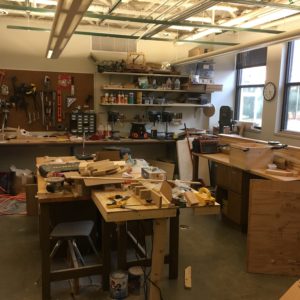Hi all,
I’m a hobbyist (I actually prefer working on cars, but pine is cheaper than billet) at home and I also teach a design and build class at the school where I mostly teach physics. It’s awesome to work with my hands every day and get paid, but my space is a nightmare. Picture sixteen teenagers with hammers and power tools in a space only slightly larger than a 1-car garage. Did I mention that it’s also where I have to store all of my materials and all of the kids’ projects in progress? Anywho, one of the biggest nightmares in this tiny space (other than the constant fear that someone will bump into another student while squeezing behind them and cause them to amputate a finger) is trying to work with 4×8 sheets. If I lay one flat to cut it up with a circular saw or track saw, it takes up half the available workspace in the room. And, of course, you’d have to clear that space before you could lay it flat, which means moving eight projects…
The solution I’ve settled on is an upright panel saw. The ones I can find online range from two to five thousand dollars for the size and features I want, and that’s not in the budget. Also, those models look like the setups they have in the big box stores and those cuts never seem to be straight/square. Instead, I’m going to build my own and I’ve set the budget at $300. I know you can make a decent track saw for $20, but I don’t have space to lay sheets flat, and I need this thing to be teenager-proof in terms of its operation and safety. The new setup must have the following:
-Dust Collection
-A Router Insert
-Rip and Crosscut Capabilities
-Locking Casters
Things are going well so far. I made my first crosscuts today and managed to tweak things until I was less than 1/16th off corner-to-corner on my finished 4’x4′ piece. My counterweights are temporary, but I’m happy with the balance and the whole setup has just enough friction that the saw stays put wherever you let it go. The “plate” that the circular saw is mounted to can be pressed in up to an inch so that it rides against the sheet you’re cutting and stops tear-out. I haven’t put in the toggle clamp “brakes” that hold the carriage in place, so I haven’t tried an 8-foot rip yet. Still need to build the dust collection housing around the saw, make the swappable router insert, and build the rest of the rolling frame. I’m going to add a rack in the back to store all of my sheet stock, too, so I can free up some wall space. I know it’s a big tool, but it’s footprint is way less disruptive than what I’ve been doing, and I’m hoping to move the class into a bigger space soon. Let me know what you all think and if there’s anything you’d add. I’ll do a video tour on Youtube when I have it all finished so you folks can see all the features. If it all goes well, I may make an adapted version that folds up into my garage ceiling at home.


















Replies
I may be breaking the "don't be a jerk" rule, but the engineer in me had to comment. This will likely never work as well as you want it to work.
You have a lot of good stuff going on here, but the whole slide/track mechanism won't be as precise as you need. You have no torsional rigidity in the track and it will skew out of square with cuts. You have too much going on with the sled to every make it work well. Just to much error.
I have been trying to figure out a better way, but I don't have a solution for you. There is some good stuff here.
1. I like the saw mount, but it will be hard to keep it square. You may want to place guides around the whole saw plate to help with alignment.
2. The whole frame that supports the plywood is fine.
3. The saw should cut up. It will make things safer since you will be pushing the saw forward instead of backwards. The saw is designed to be pushed forward.
As for improving the track, I would use a piece of plywood about the size of your rectangular frame. I would use dovetail ways, angled slides to align the sled and keep it tight to the track. You could add small adjustable plates to allow for future adjustments. This is how most cast iron tools function.
That is all I have for suggestions. I'm sorry to be a bit of a jerk, but when I look at the track and sled, I see to many areas with potential movement to give you a simple, repeatable, accurate panel saw. And we can all admit, the most frustrating thing in a shop is inconsistency.
I commend you on working with teenagers in a wood shop and I hope things work out well.
looks good.
I too have concerns about the accuracy of the mechanism, but I think it can be fixed later if this is an issue.
I also agree with cutting up.
I like the PVC pipe for the supports - you probably don't need the 90 degree bends!
Suggestions:
I think this will be a little unstable when cutting thicker sheets - say 18mm MDF or heavier. Not an issue for halving boards, but there is insufficient support at the ends of the device for cutting a small piece off, say to ensure a board is truly square. Consider a base that extends the full width of the machine.
Tilting the whole thing backwards at 15 degrees will make your counterweights harder to use but will automatically hold the board in place.
Although not what you specified, this may be a closer fit for your needs: https://www.youtube.com/watch?v=eHpFGtBsl9k
Woodsmith magazine has plans for one too. I to want to commend you for give time to kid's you should be proud of yourself.
“[Deleted]”
Hey guys, thanks for the feedback! And, no, I don't think you're violating the "don't be a jerk rule" by giving me feedback after I asked for it. I also recognize that in this case, a picture does not say 1000 words, so I'll address a few points:
-the saw cuts down because that's how every commercially available panel saw I've seen operates. The circular saw is mounted facing down, so it is cutting as intended. I think the reason they operate this way is so that the motion of the blade pushes the stock down into the base instead of up into... space. It also helps with dust collection, as most of the dust is being generated at the bottom of the tool.
-I fully agree that the current system for attaching the carriage to the linear rails is UGLY. I will likely redo in either hardwood or laminated 3/4 ply to increase rigidity and save weight. Even without tur dust collection and the final electrical switch and handle setup, the counterweight is already 20kg, and that's too much. That said, even in its current ugly 2x4 configuration, there is no real slop. The linear rails are built for cnc applications, are dead straight, and have less than 0.2mm of travel in the bearing blocks. I've seen product reviews where people are using them in overhead systems with 500lb loads. Even without the frame fully supported (it will be when I build in the storage rack and add the casters) I'm less than 1/16th out corner to corner on a 4'x4' piece. That's as square as a 4x8 sheet with factory corners. As for the cut, I couldn't get a 1/32 feeler gauge anywhere between the cut edge and my best straight-edge. That's way better than a circular saw with an edge guide, a little better than my table saw (which is admittedly crap), and almost as good as my jointer.
-the frame is tilted back (10 degrees). It does make the counterweight setup more of a pain like you said, but I agree the safety is worth it.
-the pvc elbows are there to give me a little extra diameter for easier sliding. I could have used bigger pipe, but I didn't have a big enough forstner and I thought a hole-saw would be too sloppy. The elbows will also stop sheets from getting de-railed while you push them through for rip cuts. I haven't tested that feature yet, and I'm sure they will be sloppier than the crosscuts.
-When I put in the dust collection, I'm going to zip-tie the trigger and wire in a tablesaw style safety switch so that the user doesn't have to hold the saw handle or trigger (a huge source of current slop and discomfort). I'll also put in two beefy handles so that the user can move the carriage and saw plate with both hands. I may also put in a push-button kill switch at the bottom of the frame so that the saw shuts off automatically at the end of a cross cut or so that the user can step on it to kill the saw without taking their hands off the handles.
-I'm also anxious to see how it handles thicker material like 3/4 mdf. I'm hoping that having that huge saw plate resting flat against the sheet helps keeps everything square/stable. As for edge-trimming. I agree it'll be too wobbly for that, so I'll just advise kids not to push in the saw plate for those cuts as it's rock steady when retracted into the carriage.
I know it's not as slick as some of the commercially available stuff, but it will make cleaner, safer cuts in the hands of an untrained teenager than a track saw and it solves some of my space issues. If you can make a straighter cut for $300, let's see it! Also, does anyone have any ideas on an attachment for miter cuts (that would really add a whole new degree of functionality)?
I'm not an engineer nor a physicist, but I'd add feet to the outboard ends of the bottom brace/support just to keep it from teetering. If you're securing it to a wall that wouldn't be necessary but with your space I'd imagine there's no place to keep it permanently.
For miters you're going to have to tilt the sheet as the saw is fixed. So a sliding rail on the bottom, with an adjustable fixture that clamps the wood in place would be needed (and a slider would have to have clamps so it didn't move once the sheet is in cutting position). That would replace your PVC ells as it would remain affixed to the unit. Tilting an 8x4 sheet will make it taller in effect, so the working height of the stand would have to be able to accommodate it, unless you can drop the point below the current level (which still may not be enough room). There's some geometry involved there which I'm sure you're quite qualified to calculate :)
Some pretty clever ideas there actually. Interesting post.
This forum post is now archived. Commenting has been disabled